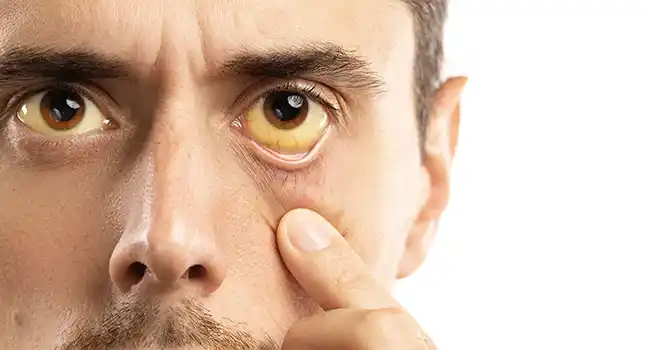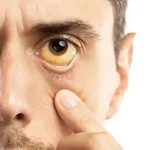Why do our eyes sometimes become yellow?
When we talk about the causes of yellow eyes, the first thing that comes to mind is jaundice. When you have jaundice, your eyes’ sclera, or whites, frequently turn yellow. Yellow eyes can occasionally be brought on by medication or specific medical conditions.
The sclera, or white of the eye, should always appear white. It’s essential to consult an ophthalmologist if this area of your eye is red or discolored so they can figure out the cause. Yellow eyes, also known as conjunctival icterus, are one type of discoloration of the front of the eye. Jaundice eyes are occasionally described using the phrase scleral icterus.
Jaundice, a skin and eye discoloration brought on by excessive amounts of the pigment bilirubin, is primarily described by yellow eyes as one of its symptoms. This occurs because your bloodstream contains an excessive amount of bilirubin. Hemoglobin-related bilirubin is a component of your typical blood composition.
Various types of jaundice
Three primary forms of jaundice are as follows:
- Prehepatic:
Excess unconjugated bilirubin is created in prehepatic jaundice, quicker than the amount the liver can conjugate for elimination. Before plasma bilirubin concentrations increase, the liver can eliminate six times the average daily load.
- Hepatic:
Hepatic cell dysfunction occurs in this type of jaundice. As a result, the liver is unable to conjugate bilirubin. While conjugated bilirubin is eliminated normally, unconjugated bilirubin remains in the bloodstream and causes jaundice.
- Posthepatic:
Higher levels of conjugated bilirubin are produced because of this, which happens after the liver has digested the waste.
Causes of yellow eyes
Jaundice can affect newborns, kids, and adults, while the causes vary depending on the age group. For example – yellow eyes in adults may have different symptoms and causes compared to kids. Although it isn’t a separate disease, jaundice yellow eyes are an indicative sign of a diseased liver, gallbladder, and bile ducts. Numerous conditions can lead to jaundice. If the type of jaundice is identified, specific yellow eye causes can be located and classified. Here we’ll go through some of the leading causes of jaundice yellow eyes-
Sickle cell anaemia disorder: Red blood cells with a crescent shape are a feature of the rare genetic disease known as sickle cell anaemia. RBC ideally have a disc form, which can cause them to die more quickly, resulting in more bilirubin to be produced and the symptoms of jaundice eyes. Your body produces sticky, bent red blood cells as a result of them, and they accumulate in your liver and begin to die more quickly than your liver can remove them.
- Liver:
Red blood cells are broken down by the liver, which plays a significant role in your body. Yellow eyes can be brought on by illnesses that alter the liver’s functionality. Any liver failure can result in cirrhosis, also known as liver scarring. The following factors can contribute to it: Liver cancer, liver infection, Hepatitis B and C, and alcohol disorder, which results in alcoholic jaundice eyes.
- Gall bladder:
Bile from your liver, which is stored in your gall bladder and is connected to your liver through bile ducts, aids in the digestion of lipids. Your bile duct may get blocked by diseases such as gallstones, cysts, and tumors. Bile builds up when the bile ducts cannot convey it, resulting in yellow eyes. Gallstones are calcium deposits that build up in the gallbladder and can seriously impair the bile ducts’ ability to operate normally.
- Hepatitis:
Hepatitis is an infection of the liver. A virus-like hepatitis A, B, or C that affects liver cells is frequently the reason. This long-term infection lasts for at least six months; however, it can also be short-lived. The liver is damaged by hepatitis and is less able to filter bilirubin. This can lead to jaundice and yellow eyes.
- Pancreas:
A glandular organ known as the pancreas, it produces several vital hormones for human health. It is a crucial step in the digestive process. The hormones and digestive enzymes generated by pancreas help in digestion. The duct from your pancreas travels to the small intestine along with the bile duct. If the pathway is diseased or blocked, jaundice eyes may result from bilirubin build-up.
Yellow eyes symptoms
Several yellow eye symptoms may exist depending on what causes your eyes to become yellow in the first place. In any case, you’ll see that your sclera, which is typically white, will start to take on a yellowish tint. General yellow eyes symptoms may also include the following:
- Nausea
- Vomiting
- High fever
- Appetite loss
- Dark urine
- Fatigue
- Lack of hunger
- Weakness
- Joint or muscle aches
- Abdominal pain
- Skin, mucous membranes, and eye whites that have a yellow tint
Yellow eyes treatment
Ask your doctor for medical advice before attempting any home remedies or other alternative treatments for jaundice. Your doctor can diagnose the potential reason for your yellow eyes and provide you with a more thorough course of yellow eyes treatment. The type of underlying illness will always determine the kind of treatment for jaundice. Here are some treatments –
- Pre-hepatic jaundice:
The goal of treating pre-hepatic jaundice is to stop the rapid red blood cell decomposition that raises the blood’s bilirubin level. This takes place before your liver suffers any harm. Malaria and sickle cell anaemia are a couple of the disorders that contribute to it. Your doctor will probably give you medicine to treat the underlying cause or ease symptoms. If it’s caused by sickle cell anaemia, they might advise a blood transfusion, rehydration via an intravenous (IV) line, or medicines like hydroxyurea (Droxia, Hydrea).
- Intra-hepatic jaundice:
If your liver has already suffered liver damage, you will have this kind of jaundice. It is frequently brought on by liver scarring or infections such as viral hepatitis. Antiviral medications can aid in treating viral liver infections, eradicating the cause of your jaundice and safeguarding you from other liver infection-related consequences. Preventing more liver damage is the primary goal of treatment.
- Post-hepatic jaundice:
This kind of jaundice develops when a bile duct is blocked, preventing the liver’s ability to excrete bilirubin and other waste products. Surgery to open the bile duct system is advised in most cases. The gallbladder, a portion of the bile duct, and a part of the pancreas are removed during this procedure.
Why CFS?
Our primary goal is to preserve and restore vision through our extensive programs, cutting-edge research, high-quality patient treatment, and multidisciplinary, integrative training. Everything we do ensures that individuals of all ages in our society have a healthy, clear vision.
We’ve grown and established a variety of clinics for different eye conditions over the years, including glaucoma, cataracts, myopia, squint alignments, and many more. To ensure every surgery is carried out with the utmost care and accuracy, we have a dedicated team well-equipped with the most recent technology and research facilities.
Article: Understanding Lasik Surgery: Before and After | Centre For Sight
Author: CFS Editorial Team | Sep 21 2022 | UPDATED 02:00 IST
*The views expressed here are solely those of the author in his private capacity and do not in any way represent the views of Centre for Sight.





